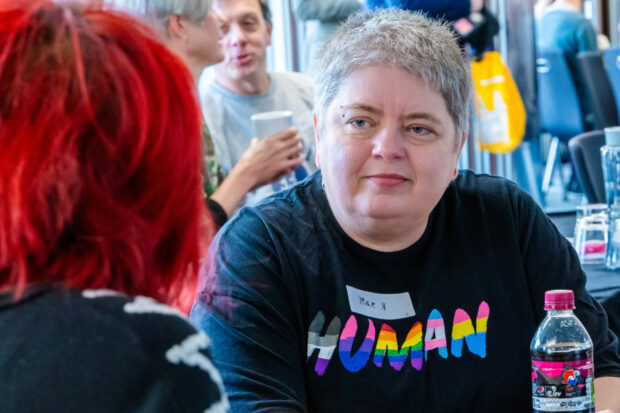
You don’t have to be a designer to use or to care about design.
In fact, most people who are doing the most powerful design work in our public services don’t call themselves designers at all. They’re council workers, service managers, health workers. What they have in common is that they’re changing how public services and places are created by starting with the people who use them.
This is what public design is about. And it’s at the core of the Design Council’s latest report, Public Design Beyond Central Government.
Public design is not just a strategy or concept, but something hands-on and increasingly urgent. Because if we want to tackle the climate and nature crises, improve health outcomes, and restore public trust, we must change how we work. Design is one of the best tools we’ve got.
What we did
Over 2022-2024, the Design Council worked with the UK's Civil Service, the Arts and Humanities Research Council, and a group of leading design academics on a review of design in the public sector. We ran a nation-wide survey of 1,000 public sector workers, contributed our case studies and evidence, and held workshops with public sector designers to explore and distil values, challenges, and recommendations. Our focus was on those outside central government: Local authorities, the NHS, the police, emergency services, and other bodies.
So, what is public design?
Design is not just about logos or apps (though those things matter too).
Design in the public sector is about working differently in starting with people’s needs. It’s about listening, co-creating, testing ideas early, learning from what doesn’t work, and adjusting as we go. It’s about understanding how people actually experience public services and places; and then reshaping them to make them better.
You might hear this called “service design,” “policy design,” “co-design,” or even “strategic design.” But at its core, it’s just this:
Design is how we make decisions about what to do – and how to do it – in a way that makes life better for people and the planet.
Design is not confined to one role or job title either. As our survey showed, 58% of public sector workers already use design in some way, even if only 13% would call themselves experts. Overall, an impressive 88% of the public sector say design plays a role in their organisation.
What design looks like in action
Let’s look at a couple of examples of what this means in the real world.
- In Amble, Northumberland, local people helped reimagine their town after a major employer shut down. With the help of the Design Council and their local authority, they co-designed a vision for a food and tourism destination. That design-led regeneration brought in new businesses, created jobs, and helped the town win High Street of the Year.
- In Staffordshire, design helped the council better support children at risk. Families, service providers, and local partners worked together to redesign how early years services were delivered. A new approach reduced stigma, increased engagement by 300%, and brought “hidden” children into view.
- At Transport for London, staff used design methods to rethink occupational health services. By listening to employees and testing small changes, they made it easier for workers to access health checks, leading to better prevention and stronger relationships between departments.
These aren’t stories about design as a nice-to-have but as a way of working: Understanding the problem rather than jumping to solutions.
This matters now
Public services are under pressure: Budgets are shrinking; demand is rising; people’s trust is wobbling.
This could be the moment when organisations retreat, cutting what they see as extras. But cutting design would be a mistake.
Design helps avoid costly errors by catching problems early. It builds public trust by involving people in shaping the services and places they use. It creates more joined-up, efficient systems by helping teams work across siloes. And it gives public servants the confidence to test, learn, and adapt. Because no complex challenge can be solved with a one-size-fits-all plan.
As the report puts it: “There’s no greater waste of public money than to have the best solution to the wrong problem.”
A design-literate government
We’re seeing a growing movement of public servants embracing design. The Design Council has worked with over 100 councils across England, building design capacity from the ground up.
But to make this stick, design needs to be treated as a core capability.
That means:
- Creating senior design roles in public bodies – people who can champion and scale good design.
- Investing in training for all public servants so they can understand and use design approaches.
- Making it easier to procure good design work and to connect with local design talent.
- Building shared standards, frameworks, and communities of practice.
- Making space for testing, iteration, and feedback loops so that new ideas don’t just sit in a drawer.
The bottom line
Design isn’t a silver bullet. But without it, mission-led government risks becoming just another set of slogans.
Design is how we build public services and places with people, not for them. It’s how we make smarter decisions, moving from intention to impact. And how we make those hard missions – net zero, healthy lives, safe streets – a little more achievable.
Join our community
We use this blog to talk about the work of the multidisciplinary policy design community. We share stories about our work, the thinking behind it and what policymaking might look like in the future. If you would like to read more, then please subscribe to this blog. If you work for the UK's government, then you can you join the policy design community. If you don't work for the UK government, then connect with us on social media at Design and Policy Network and subscribe here to be notified about our monthly speaker events to hear from influential design thought leaders and practitioners.